Modern Art
As already noted, modernism is a philosophical movement that, along with cultural trends and changes, arose from enormous transformations in Western society during the late 19th and early 20th centuries. Among the factors that shaped modernism were the development of modern industrial societies and the rapid growth of cities, followed by the horror of World War I.
While there are varying opinions, one historical framing of “Modern Art” begins with the Realist Movement (usually connected the revolutionary year of 1848) and ends with Abstract Expressionism, which is sort of a bridge between modern and postmodern art. Many artists embraced the new techniques and innovations, the spirit of progress, invention, discovery, creativity and change. They wanted to participate in creating the modern world and they were anxious to try out new ideas rather than following the more conservative guidelines of Academic art (representational images often depicting grand stories from history, mythology, religion). Paintings and sculptures began to look different: visible signs of brushstrokes, a growing disregard for representational art, innovative compositions, a focus on formal qualities, increased abstraction, etc. This is not to say that these mid-nineteenth century artists were the first to challenge an older generation or set of ideas. Many academic artists had argued over formal issues, styles and subject matter but this was much like a good-natured agreement within a club; everyone in the group agreed to disagree.
Early Modern Art
Realism
As the Romanticism period dominated the first half of the 19th century and Realism dominated the second half. The name Realism itself implies the type of art, beginning as a way to paint photographically, with precise detail using the occupational pursuits of the peasants, the current rage by artists as the subject to paint. Paris transformed a medieval jumble of streets and narrow alleyways to an impressive metropolitan center with expansive streets and multi-class residences. An emerging middle class was transforming the look of Paris, and the citizens promenaded down the boulevards to shop, socialize and dine, a reflection of higher income and additional leisure time.
The father of Realism was Gustave Courbet (1819-1877), a French artist who lived in Paris during a time of significant change. Le Sommeil (The Sleepers) is one of Courbet’s most controversial paintings depicting two women in suggestive entwinement on a bed of beautifully rendered textiles. Courbet used subtle coloring to define the curves of the women, one with loose, dark hair, the other with red curly hair. After Le Sommeil was displayed, many artists copied the lesbian theme, the duplication helping to lower the taboos accompanying gay relationships in Paris.
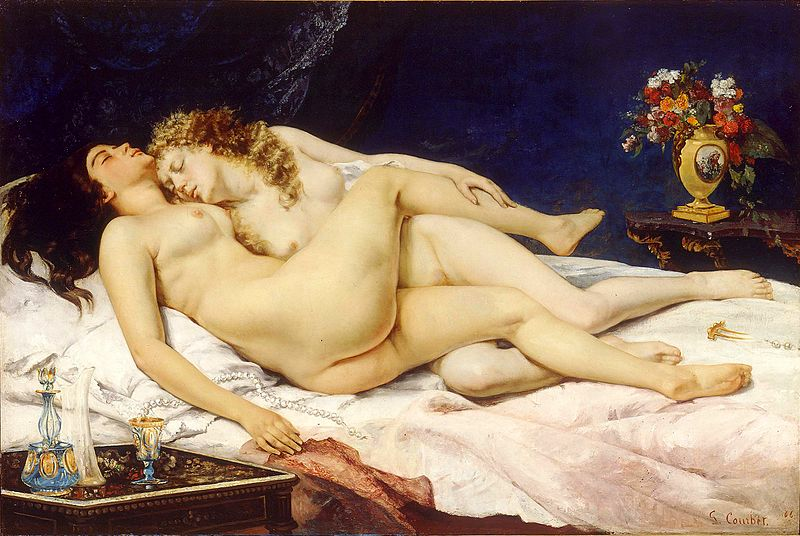
Le Sommeil
In Swimming Hole, the painting of the American realist painter and fine arts educator, Thomas Eakins (1844-1916), depicted an American genre painting, the all-male nude group swimming in a small lake, anywhere, USA. Eakins also defied the narrow-minded Victorian arrogance towards nudity. The human body was challenging to portray; however he masterfully rendered six complex figures, each one seemingly in motion. The male nude form had disappeared since the renaissance, and now it was reemerging.
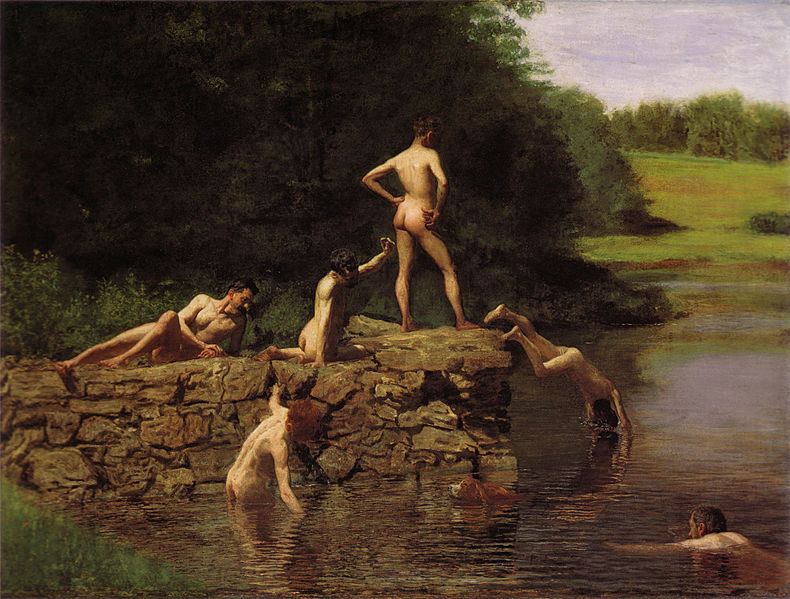
The Swimming Hole
If Courbet painted realistic women, Rosa Bonheur (1822-1899) was the painter of realistic animals, one of the greatest celebrated female painters of the 19th century. Bonheur grew up a precocious young girl at the side of her father, who was an artist. At age 14, she started sketching in the Louvre, learning the fundamentals of classical painting and the foundation for painting Plowing in the Nivernais. The blue sky occupies half the painting, the enormous, aligned oxen pulling a plow, creating a contrapuntal slope to the hill. The painting is exceptionally realistic; the viewer might nearly smell the fresh dirt turned over by the plow….
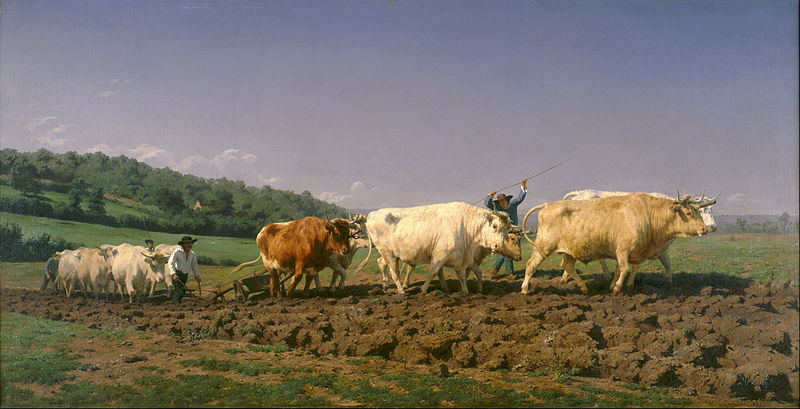
Plowing in the Nivernais
From Realism to Impressionism: Manet
Édouard Manet (1832-1883) was a French painter and a fundamental artist transitioning art from Realism to Impressionism. Olympia (11.11) is a reclining nude woman lying on the bed covered in silky white satin sheets; however, it is not her nudity deemed to be offensive – it was her gaze that shocked the audiences. A servant, hidden in the background, cradles a bouquet, presumably from a suitor, the black cat arching its back on the foot of her bed, concealed in the shadows. Goya’s nude Maja started directly at the viewer, Olympia appears confrontational, as if she is staring at the unseen fantasizer. “The critical reaction to Olympia was decidedly negative. Only four critics out of sixty were favorably disposed to the picture…”
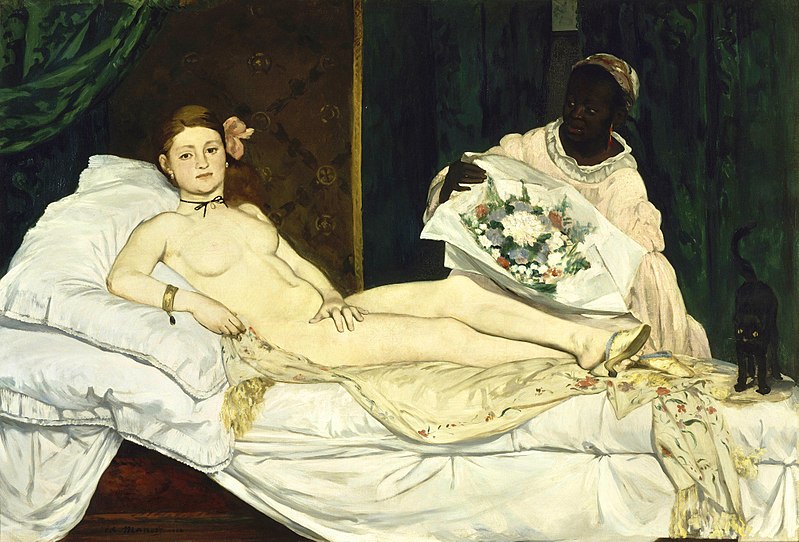
Olympia: “Shocking” was the word used to describe Manet’s Olympia in 1865 when it was first unveiled.
Impressionism
Impressionism is a 19th century movement from 1860 to 1886 known for its paintings that aimed to depict the transience of light, and to capture scenes of modern life and the natural world in their ever-shifting conditions.

London, Houses of Parliament. The Sun Shining through the Fog, Claude Monet, 1904: Monet is considered the most consistent and prolific practitioner of the Impressionist philosophy of expressing one’s perceptions before nature.
In that short time, it completely changed art forever. Until the 1860s, Romanticism and Realism, with the photo-like quality of painting, controlled the art world. Impressionists ultimately rejected all known art styles and began to paint with awareness, stylistic abandonment, and captured brief glimpses of a moment in time, and painted en Plein aire. Earlier in the 19th century, the tin tube was invented, freeing the artists to carry multiple colors of paint to a site and using broad brushstrokes, capture the light, intensity, and hues of natural environments.
Impressionism received its name one day when a newspaper writer wrote a review of the first Société Anonyme des Artistes. He was viewing Claude Monet’s painting, Impression Sunrise, and called the article “Exhibition of the Impressionist.” At first, the name was sarcastic, but it stuck; the style and artists associated with the techniques are called Impressionists.
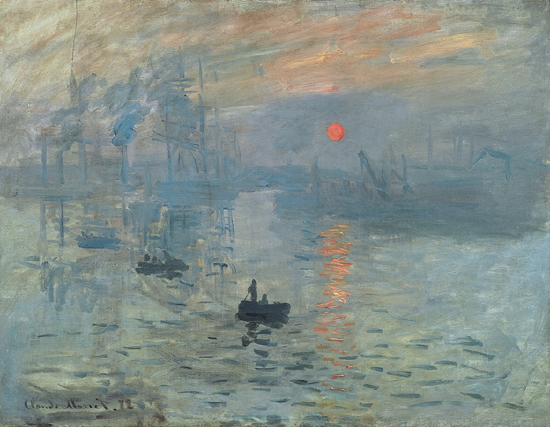
Impression Sunrise
Claude Monet (1840-1926) was one of the most consistent and prolific painters of the Impressionist period. Using paint freely on the canvas and using intense pure color is characteristic of impressionism. The artists also painted outside to capture the fleeting light. Monet frequently painted a series from the same position to demonstrate how the changing light affected the appearance and impression of the painting. He went to Venice, painting six images of the Grand Canal. In Grand Canal Venice and The Grand Canal, the two paintings demonstrate how light changes the colors, depth of the shadows, and mood of the location.
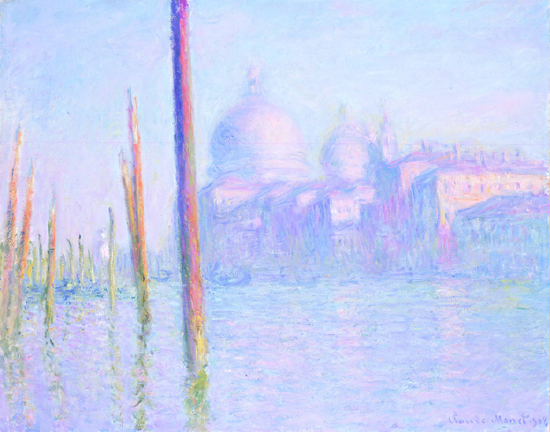

Monet bought several acres of land with a house in Giverny, France, transforming the area into a masterpiece garden setting. The garden, dominated by archways, roses, flower beds, and the water lily pond and bridge, became the centerpiece of a large number of his paintings, the most well-known based of the water lilies. The Water Lilies and Japanese Bridge represent the pond with cool greens, reflective water, and the iconic Japanese footbridge. He generally set up multiple canvases around the pond and painted at different times of the day. The water in Waterlilies reflects the bright sunlight of the day, individual lily pads floating on the surface with delicate flowers. In The Water Lily Pond, the reflective sun is limited to the side of the painting. The rest of the pond rests in shadows from the trees, and the lily pads show differing in light or shadows.
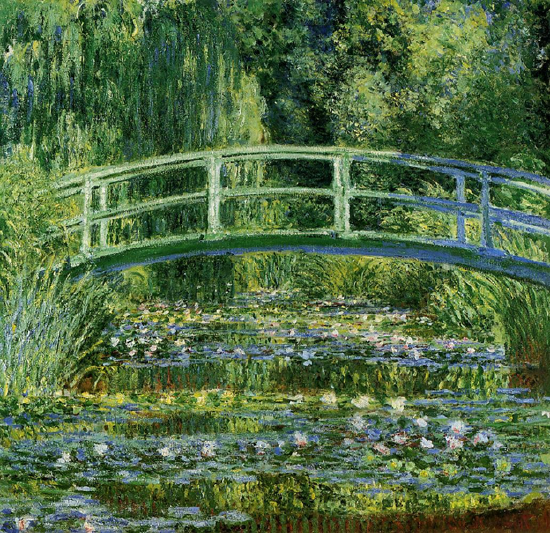
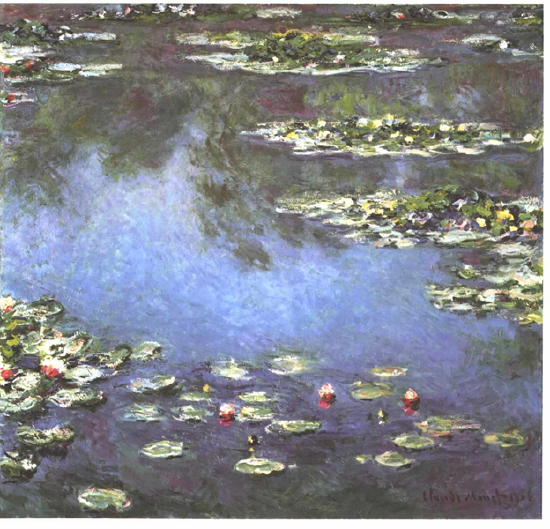

Auguste Renoir (1841-1919) attended art school in Paris with many of the artists, including Monet, who embraced the new ideas of painting. Renoir relished the renaissance artists yet loved the painting style of the impressionists. On Sundays, the working people went to the cafes to eat, drink and dance. Renoir captured the scene in Le Moulin de la Galette, painted with fluid brushstrokes to create the dappled sunlight reflecting on the exuberant dancers. The painting is a snapshot of ordinary life, which is the theme of the Impressionists. The painting was accepted into a Salon, advancing his credibility as an artist. Renoir frequently sat along the Seine, painting scenes of people engaged in ordinary activities. The two sisters in Two Sisters (On the Terrace) are sitting by the river with a basket filled with balls of wool. The trees and rivers painted in loose, broad brushstrokes in muted colors and the two girls dominate the foreground with intense, contrasting colors of white, blue, and red.
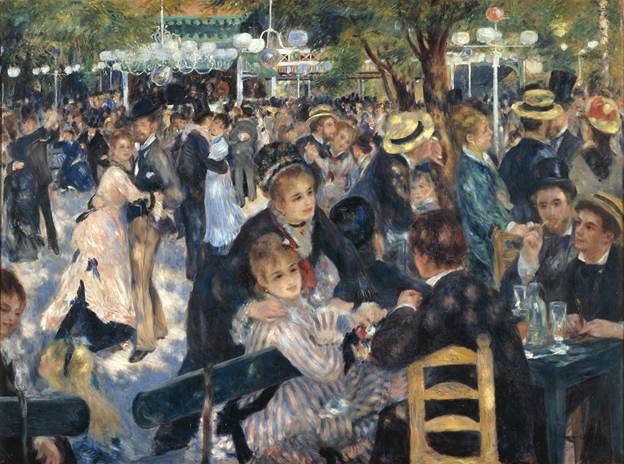
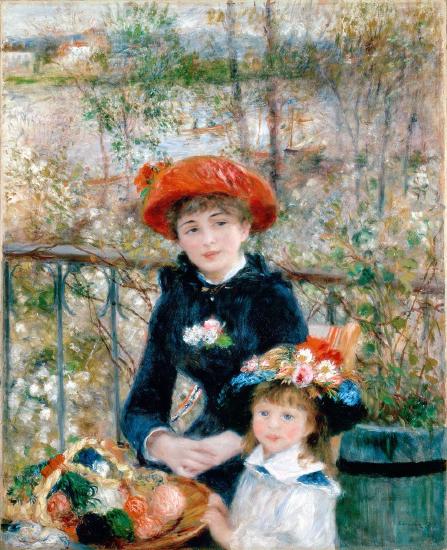
In painting, during the 1920s and the 1930s and the Great Depression, modernism is defined by Surrealism, late Cubism, Bauhaus, De Stijl, Dada, German Expressionism, and Modernist and masterful color painters like Henri Matisse as well as the abstractions of artists like Piet Mondrian and Wassily Kandinsky, which characterized the European art scene. In Germany, Max Beckmann, Otto Dix, George Grosz, and others politicized their paintings, foreshadowing the coming of World War II, while in America, modernism is seen in the form of American Scene painting and the social realism and regionalism movements that contained both political and social commentary dominated the art world.
Three women contributed to the Impressionism period with their styles and paintings. Mary Cassatt (1844-1926), Berthe Morisot (1841-1895), and Marie Bracquemond (1840-1916) considered the ‘Grand Dames of the Impressionists’. Morisot and Bracquemond were native to France, and Cassatt was born in America, moving to France for art school. Their styles were all similar and focused on women, children and nature, everyday life, and shared activities. The viewers of the work captivate the viewer with the use of free brushwork up close and standing far away. All three women were master painters, and if they were men, they might have been considered the top three artists of the Impressionism period.
Mary Cassatt mostly created paintings or prints of the private lives of women and their children. The close-cropped scenes have an emphasis on the intimate bonds that only a mother and child can have, as seen in The Child’s Bath. Cassatt used simple muted colors to portray the ordinary scene, one not found in paintings by men. Morisot’s Child Among the Hollyhocks shows a child exploring the flowers. She liberally used loose brushstrokes of white paint to bring accents and movement to the painting. Bracquemond’s scene in Artist’s Son and Sister in the Garden at Sevres is also a simple setting, but the use of color brings the subjects to life. Women seldom painted in public spaces or landscapes, their work generally confined to gardens or spaces in their homes or neighborhoods.
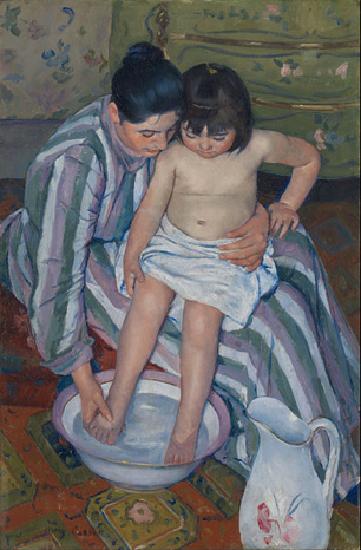

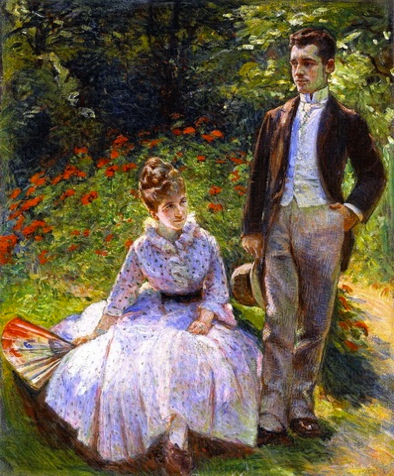
Impressionist Sculpture
Modern sculpture, along with all modern art, “arose as part of Western society’s attempt to come to terms with the urban, industrial and secular society that emerged during the 19th century.” Typically, modernist artists were concerned with the representation of contemporary issues as opposed to grand historical and allegorical themes previously favored in art.
Rodin’s Influence
Modern sculpture is generally considered to have begun with the work of French sculptor Auguste Rodin. Rodin, often considered a sculptural Impressionist, did not set out to rebel against artistic traditions; however, he incorporated novel ways of building his sculpture that defied classical categories and techniques. Specifically, Rodin modeled complex, turbulent, deeply pocketed surfaces into clay. While he never self-identified as an Impressionist, the vigorous, gestural modeling he employed in his works is often likened to the quick, gestural brush strokes aiming to capture a fleeting moment that was typical of the Impressionists. Rodin’s most original work departed from traditional themes of mythology and allegory, in favor of modeling the human body with intense realism, and celebrating individual character and physicality.
Rodin was a naturalist, less concerned with monumental expression than with character and emotion. Departing with centuries of tradition, he turned away from the idealism of the Greeks and the decorative beauty of the Baroque and neo-Baroque movements. His sculpture emphasized the individual and the concreteness of flesh, suggesting emotion through detailed, textured surfaces, and the interplay of light and shadow. To a greater degree than his contemporaries, Rodin believed that an individual’s character was revealed by his physical features. Rodin’s talent for surface modeling allowed him to let every part of the body speak for the whole. The male’s passion in The Kiss, for example, is suggested by the grip of his toes on the rock, the rigidness of his back, and the differentiation of his hands. Rodin saw suffering and conflict as hallmarks of modern art. He states that “nothing, really, is more moving than the maddened beast, dying from unfulfilled desire and asking in vain for grace to quell its passion.”
The Thinker by Auguste Rodin: Rodin’s experiments with form, visible in the Thinker, launched modern abstract sculpture.
Rodin’s major innovation was to capitalize on such multi-staged processes of 19th century sculpture and their reliance on plaster casting. Since clay deteriorates rapidly if not kept wet or fired into a terra-cotta, sculptors used plaster casts as a means of securing the composition they would make out of the fugitive material that is clay. This was common practice among Rodin’s contemporaries: sculptors would exhibit plaster casts with the hopes that they would be commissioned to have the works made in a more permanent material. Rodin, however, would have multiple plasters made and treat them as the raw material of sculpture, recombining their parts and figures into new compositions and new names. As Rodin’s practice developed into the 1890s, he became more and more radical in his pursuit of fragmentation, the combination of figures at different scales, and the making of new compositions from his earlier work.
The Walking Man
A prime example of his radical practices is The Walking Man (1899–1900). It is composed of two sculptures from the 1870s that Rodin found in his studio — a broken and damaged torso that had fallen into neglect and the lower extremities of a statuette version of his 1878 St. John the Baptist Preaching that he was having re-sculpted at a reduced scale. Without finessing the join between upper and lower, between torso and legs, Rodin created a work that many sculptors at the time, and subsequently, have seen as one of his strongest and most singular works. This is despite the fact that the object conveys two different styles, exhibits two different attitudes toward finish, and lacks any attempt to hide the arbitrary fusion of these two components. It was the freedom and creativity with which Rodin used these practices—along with his activation of the surfaces of sculptures through traces of his own touch—that marked Rodin’s re-making of traditional 19th century sculptural techniques into the prototype for modern sculpture.

The Walking Man: The Walking Man is composed of two fragments of sculpture that Rodin combined into a single work without masking the fusion of these disparate forms.
Edgar Degas
Edgar Degas was a French artist famous for his paintings, sculptures, prints, and drawings. He is especially identified with the subject of dance; more than half of his works depict dancers. He is regarded as one of the founders of Impressionism, although he rejected the term, preferring to be called a Realist.
During his life, public reception of Degas’s work ranged from admiration to contempt. As a promising artist in the conventional mode, Degas had a number of paintings accepted in the Salon between 1865 and 1870. He soon joined forces with the Impressionists, however, and rejected the rigid rules, judgments, and elitism of the Salon—just as the Salon and general public initially rejected the experimentalism of the Impressionists.
Degas’ work was controversial, but was generally admired for its draftsmanship. His La Petite Danseuse de Quatorze Ans, or Little Dancer of Fourteen Years, which he displayed at the sixth Impressionist Exhibition in 1881, was probably his most controversial piece; some critics decried what they thought its “appalling ugliness” while others saw in it a “blossoming.” The sculpture is two-thirds life size and was originally sculpted in wax, an unusual choice of medium for the time. It is dressed in a real bodice, tutu and ballet slippers and has a wig of real hair. All but a hair ribbon and the tutu are covered in wax. The 28 bronze repetitions that appear in museums and galleries around the world today were cast after Degas’ death. The tutus worn by the bronzes vary from museum to museum.
Little Dancer of Fourteen Years by Edgar Degas, c. 1881: The controversial sculpture that Degas showed in the Impressionist Exhibition of 1881 is noted for its experimentalism and breaks with tradition.
Recognized as an important artist in his lifetime, Degas is now considered one of the founders of Impressionism. Though his work crossed many stylistic boundaries, his involvement with the other major figures of Impressionism and their exhibitions, his dynamic paintings and sketches of everyday life and activities, and his bold color experiments served to finally tie him to the Impressionist movement as one of its greatest artists.
This is just an incomplete overview of this vibrant and influential period of art. Click this link for more complete discussion about modernist art.
Candela Citations
- Impressionism (1860-1890). Authored by: Deborah Gustlin & Zoe Gustlin. Provided by: LibreTexts. Located at: https://human.libretexts.org/Bookshelves/Art/A_World_Perspective_of_Art_Appreciation_(Gustlin_and_Gustlin)/11%3A_The_Industrial_Revolution_(1800_CE__1899_CE)/11.07%3A_Impressionism_(1860__1890). License: CC BY-SA: Attribution-ShareAlike
- Realism (1848-1870). Authored by: Deborah Gustlin & Zoe Gustlin. Provided by: LibreTexts. Located at: https://human.libretexts.org/Bookshelves/Art/A_World_Perspective_of_Art_Appreciation_(Gustlin_and_Gustlin)/11%3A_The_Industrial_Revolution_(1800_CE__1899_CE)/11.03%3A_Realism_(1848__1870). License: CC BY-SA: Attribution-ShareAlike
- Becoming Modern. Provided by: Lumen Learning. Located at: https://courses.lumenlearning.com/atd-sac-artappreciation/chapter/reading-becoming-modern/. License: CC BY-SA: Attribution-ShareAlike
- Provided by: Lumen Learning. License: CC BY-SA: Attribution-ShareAlike


